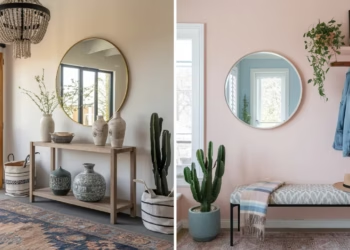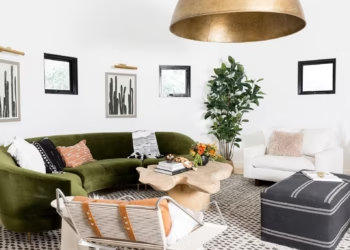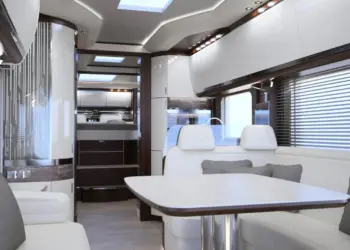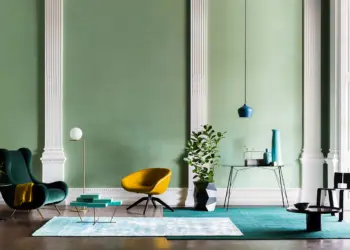The realm of interior design transcends mere furniture arrangement; it’s a harmonious blend of aesthetics and functionality. But does it stand as a lucrative career path? In this discourse, we’ll embark on an in-depth exploration of the universe of interior design to help you discern if it aligns with your aspirations.
Table of Contents
Understanding the Essence of Interior Design: What is Interior Design?
Interior design serves as the confluence of art and science, enriching interior spaces to manifest a visually pleasing and pragmatic milieu. It amalgamates creativity, technical acumen, and adept problem-solving prowess. Interior designers collaborate with clients to craft spaces that cater to their requisites and aesthetic preferences.
The Surge in Popularity of Interior Design
In recent years, interior design has basked in the limelight. A burgeoning appreciation for well-conceived spaces has ignited an unprecedented demand for interior designers. From homeowners seeking to rejuvenate their abodes to enterprises yearning for captivating work environments, the possibilities have burgeoned.
Pondering the Pros of Choosing Interior Design as a Career
For those contemplating a voyage into the realm of interior design, here are some compelling motives:
1. Unleash Your Creative Prowess
Interior design serves as a canvas for your artistic ingenuity. It offers a platform to experiment with colors, textures, and furnishings, culminating in the creation of distinctive, visually captivating spaces.
2. A Plenitude of Specializations
This domain proffers an eclectic array of specializations, spanning residential to commercial design, enabling you to find your niche amidst this expansive landscape.
3. Job Gratification
Creating aesthetically pleasing spaces that elicit delight from clients can be an immensely gratifying experience, stoking your passion for design.
4. Flexibility Abounds
Interior designers frequently relish the liberty to operate independently, as freelancers, or as integral components of renowned design enterprises, accentuating the versatility of this profession.
Surveying Career Trajectories: Career Opportunities
Interior designers can find employment across a myriad of sectors, including:
- Residential Design: An emphasis on crafting captivating homes and apartments.
- Commercial Design: Diving into the design of corporate offices, hotels, restaurants, and retail outlets.
- Hospitality Design: Specializing in the curation of welcoming and inviting spaces for travelers.
- Healthcare Design: Focusing on enhancing the functionality and aesthetics of healthcare facilities.
- Sustainable Design: Advocating eco-friendly and energy-efficient design, a burgeoning niche in the industry.
Contemplating Financial Prospects
The financial rewards of interior design are diverse, with incomes varying. According to data from the U.S. Bureau of Labor Statistics, the median annual remuneration for interior designers stood at approximately $61,590 in May 2022.
Educational Attainments
The pursuit of an interior design career typically necessitates the acquisition of a bachelor’s degree in interior design or a closely related field. Moreover, some states mandate licensure for interior designers, often entailing the successful completion of a licensure examination.
Requisite Aptitudes
Triumphant interior designers manifest a melange of proficiencies, including:
- Creative and artistic acumen
- Robust communication and interpersonal skills
- Problem-solving and adept project management capabilities
- Proficiency with design software and technological tools
- An unerring attention to detail
The Euphoria of Job Satisfaction
Interior designers frequently bask in the euphoria of profound job satisfaction. The realization of their creative visions and the joy it begets in clients coalesce to constitute a deeply rewarding endeavor.
Navigating Through the Challenges
While interior design confers myriad benefits, it isn’t devoid of challenges. These hurdles may encompass stringent budgetary constraints, exacting clients, and the imperative to remain abreast of dynamic design trends.
Cons of Being An Interior Designer
- Budgetary Restraints and Difficult Clients: Dealing with customers that have certain tastes and financial restrictions can be difficult, which has an impact on the whole design process and creativity.
- Long hours and stress: Interior designers frequently work long hours and under pressure, especially when handling several projects at once or working under tight deadlines.
- Extremely responsible: Interior designers are heavily accountable for the practicality and appeal of the rooms they create, which can put them under stress and pressure to live up to their clients’ expectations.
- Competition: With so many designers fighting for customers and projects, it can be difficult to launch a lucrative career in the competitive sector of interior design.
- Training and Education: Formal education and training are frequently necessary for becoming a skilled interior designer, which may be time-consuming and expensive.
- Industry Trends: It’s crucial to stay current with design trends and technology, which might necessitate ongoing learning and adaptation to be competitive in the field.
- Emotional Investment: Interior designers frequently develop emotional attachments to their work, which may be taxing, especially when dealing with picky customers or difficult design problems.
Charting the Course Ahead
The job landscape for interior designers is contingent on geographical location and the chosen specialization. While certain regions might exhibit heightened competitiveness, the overarching outlook remains sanguine, owing to the mounting interest in well-designed spaces.
Embarking on Your Interior Design Odyssey
For those intent on embarking on an interior design odyssey, here are some steps to initiate your journey:
- Educational Attainment and Training: Attain the requisite education and training.
- Cultivating a Robust Portfolio: Craft an impressive portfolio showcasing your design acumen.
- Gaining Practical Exposure: Garner hands-on experience through internships or entry-level positions.
- Networking: Foster connections with professionals in the field.
- Staying Informed: Remain abreast of industry trends and advancements in design software.
Real-Life Chronicles of Triumph
To provide further inspiration, here are anecdotes of accomplished interior designers who have etched their legacy in the industry:
Kelly Wearstler
Kelly Wearstler‘s impact has expanded well beyond California since The New Yorker dubbed her “the presiding grande dame of West Coast interior design” in 2009. The fashion-setter’s designs for Viceroy Hotels and Residences, Four Seasons Anguilla, and most recently, Proper Hotels in San Francisco, Los Angeles, and Austin, helped to redefine the hospitality sector. Cameron Diaz, Ben Stiller, and Gwen Stefani are among her residential clients. She has also created furniture and accessory lines for Ann Sacks, Lee Jofa, the Rug Company, Georg Jensen, and Visual Comfort in addition to her own line of home decor.
Nate Berkus
Nate Berkus made his television debut on The Oprah Winfrey Show in 2002, and since then, he has established himself as one of America’s favorite designers, garnering several TV gigs, book agreements, and collaborations. Ricky Martin is only one of the well-known customers of his namesake company, which Berkus established in 1995 when he was just 24 years old. He has also collaborated on product lines with Target, Kravet, the Shade Store, and Framebridge. He co-stars with his spouse Jeremiah Brent in the TLC series Nate & Jeremiah by Design, and the duo has launched their most current Living Spaces collection.
Emily Henderson
By transforming bookshelves, cocktail tables, and mantels all throughout the nation, designer Emily Henderson helped America boost its decorating game. Her major break came when she took first place in the fifth season of HGTV Design Star; the network then aired Secrets From a Stylist, which she hosted for two seasons. On her well-liked blog and her Instagram page, where she has more than 835,000 followers, she imparts design knowledge to devoted devotees. Styled: Secrets for Arranging Rooms, From Tabletops to Bookshelves, her 2015 publication, was a New York Times bestseller. Henderson is Target’s go-to source for home design in addition to managing her interior design business and content division.
In summary, interior design unfurls as a profoundly rewarding vocation, tailor-made for individuals harboring a passion for crafting aesthetically pleasing and functional spaces. It extends the prospect of creative expression, job gratification, and the potential for a lucrative income. Nonetheless, it is vital to brace oneself for the challenges that may materialize. If you are willing to invest the requisite effort and remain unwavering in your dedication, interior design may emerge as your quintessential career choice.
FAQs
What’s the earning potential in interior design?
The income of interior designers varies but can encompass a median annual wage of approximately $56,000. Actual earnings hinge on geographical location and professional experience.
Is interior design a competitive field?
While competition can be intense, particularly in urban centers, the adoption of specialization and the cultivation of a compelling portfolio can facilitate differentiation.
Do I need to be a great artist to be an interior designer?
While artistic talent can be advantageous, the crux of success lies in a synthesis of creativity and technical proficiency.
Can I start my interior design business?
Indeed, many interior designers eventually establish their own enterprises once they amass substantial experience and foster a robust client base.
Is sustainable design an emerging facet within the field of interior design?
Absolutely, sustainable design is gaining traction as environmental consciousness ascends. It presents an avenue for specialization in tune with contemporary eco-friendly sensibilities.
Is interior design career worth it?
Yes, it can be worth it if you have a passion for design and creativity. It offers opportunities for self-expression and can be personally rewarding.
Can you make good money as an interior designer?
Yes, experienced and successful interior designers can earn a good income, but it often depends on factors like location, specialization, and client base.
Are interior designers in demand?
Yes, interior designers are in demand, especially in urban areas where there’s a steady need for residential and commercial design services.
Is it hard to succeed in interior design?
It can be competitive and challenging, but with talent, dedication, and a strong work ethic, it’s possible to succeed in the field of interior design. Building a reputation and a client base takes time and effort.










